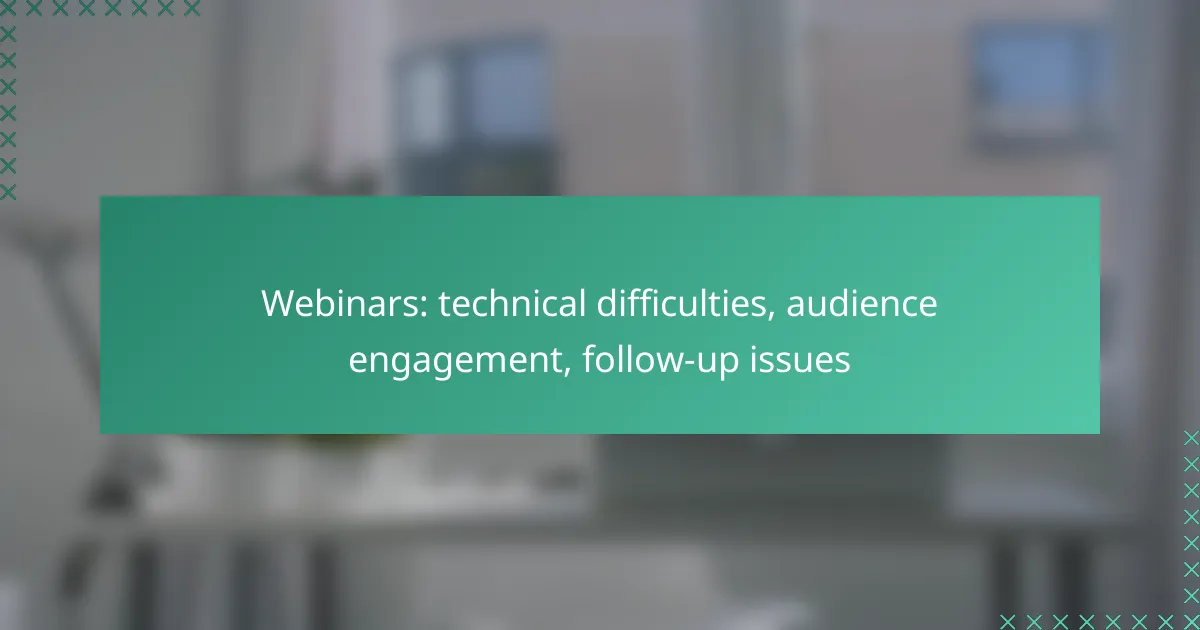Webinars can be a powerful tool for communication, but they often come with challenges such as technical difficulties, which can disrupt presentations and diminish audience engagement. To keep participants involved, it’s important to implement interactive techniques and maintain their interest throughout the session. Additionally, effective follow-up strategies are essential for reinforcing content and gathering valuable feedback to improve future webinars.
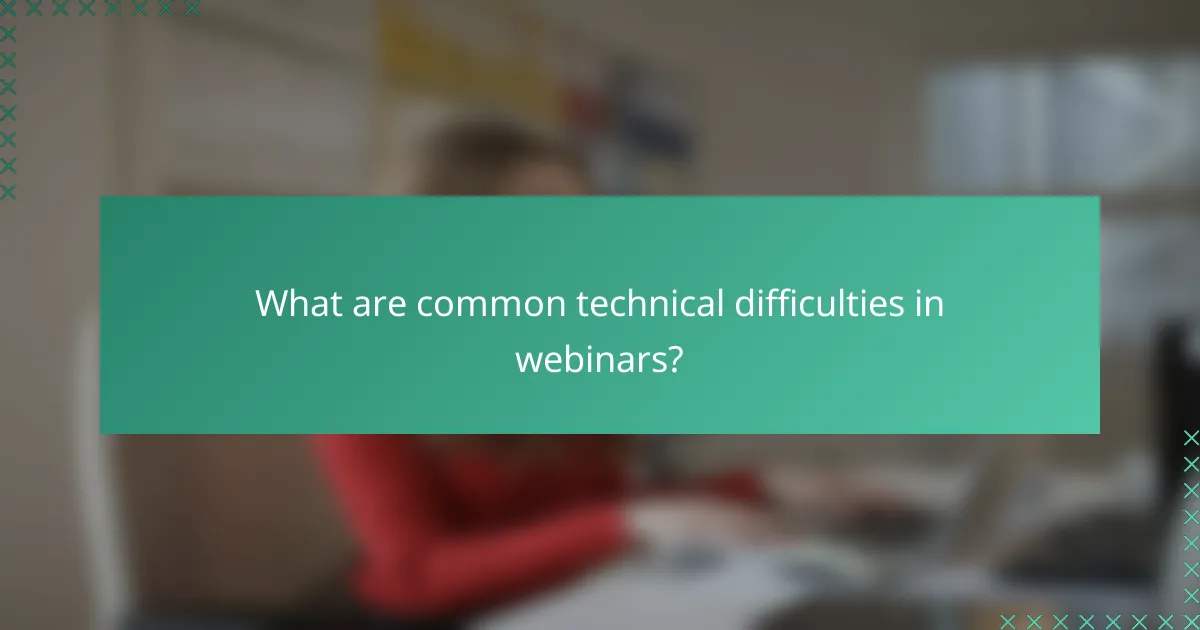
What are common technical difficulties in webinars?
Common technical difficulties in webinars include audio issues, video lag, connection drops, platform compatibility, and screen sharing problems. These challenges can disrupt the flow of the presentation and hinder audience engagement, making it essential to address them proactively.
Audio issues
Audio issues are among the most frequent problems encountered during webinars. Participants may experience poor sound quality, echo, or complete audio loss, which can significantly impact communication. To mitigate these issues, ensure that all participants use high-quality microphones and headphones, and conduct audio checks before the webinar starts.
It’s also advisable to use a reliable audio platform that offers features like noise cancellation. If problems arise, having a backup communication method, such as a chat function, can help maintain engagement while troubleshooting.
Video lag
Video lag can cause delays between the speaker’s actions and what the audience sees, leading to confusion and disengagement. This issue often stems from poor internet connections or high bandwidth usage. To minimize video lag, encourage participants to close unnecessary applications and use a wired connection when possible.
Testing the video quality beforehand can help identify potential lag issues. If lag persists, consider switching to a lower resolution or using a platform that optimizes video streaming for various connection speeds.
Connection drops
Connection drops can abruptly interrupt a webinar, frustrating both presenters and attendees. These drops may occur due to unstable internet connections or server issues. To reduce the risk, presenters should use a reliable internet service provider and consider having a backup connection, such as a mobile hotspot.
Informing participants about potential connection issues and encouraging them to reconnect quickly can help maintain the flow of the session. Additionally, recording the webinar allows those who drop out to catch up later.
Platform compatibility
Platform compatibility issues arise when participants are unable to access the webinar due to software or hardware limitations. Different operating systems and browsers may affect functionality, so it’s crucial to choose a webinar platform that supports a wide range of devices and systems.
Providing clear instructions on how to join the webinar and recommending compatible browsers can help alleviate these issues. Testing the platform with a small group before the main event can also identify compatibility problems early on.
Screen sharing problems
Screen sharing problems can hinder the effectiveness of a presentation, as participants may not see the intended content. Common issues include the inability to share the screen, poor resolution, or lag during the sharing process. To avoid these problems, presenters should familiarize themselves with the screen sharing features of the chosen platform.
It’s advisable to close unnecessary applications and tabs before sharing to enhance performance. Conducting a practice run with screen sharing can help identify any technical glitches and ensure a smoother experience during the actual webinar.
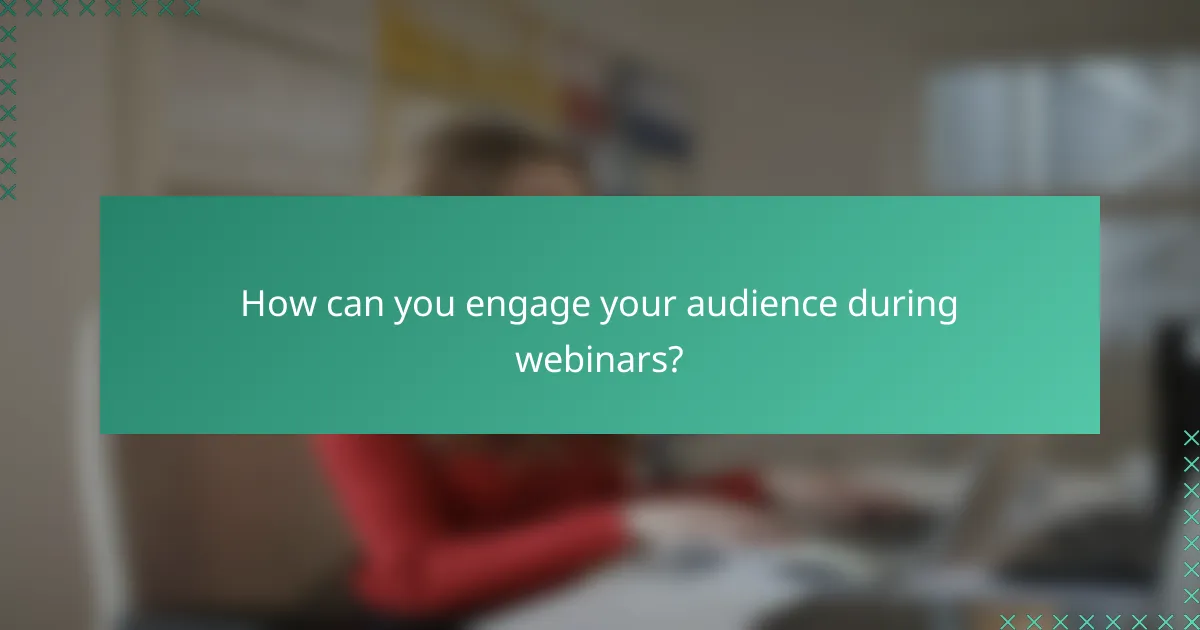
How can you engage your audience during webinars?
Engaging your audience during webinars is crucial for maintaining interest and ensuring effective communication. Techniques such as interactive polls, Q&A sessions, and gamification can significantly enhance participation and retention of information.
Interactive polls
Interactive polls allow participants to provide real-time feedback on topics discussed during the webinar. This engagement technique not only keeps the audience involved but also helps gauge their opinions or knowledge on specific subjects.
Consider using polls at strategic points, such as after introducing a new concept or before transitioning to a new topic. Aim for a balance between the number of polls and the overall flow of the presentation to avoid overwhelming attendees.
Q&A sessions
Q&A sessions provide a platform for attendees to ask questions and clarify doubts, fostering a two-way communication channel. Allocating time for questions can enhance understanding and make participants feel valued.
To maximize effectiveness, encourage questions throughout the webinar rather than just at the end. You can use a dedicated chat feature or a specific Q&A tool to manage inquiries efficiently, ensuring that all voices are heard.
Chat engagement
Chat engagement involves using the chat function to interact with participants during the webinar. This can include sharing resources, answering questions, or prompting discussions among attendees.
Encourage participants to use the chat for comments or reactions during the presentation. Designate a moderator to monitor the chat, ensuring that relevant points are addressed and that the conversation remains on track.
Gamification techniques
Gamification techniques incorporate game-like elements into webinars to boost engagement and motivation. This can include quizzes, leaderboards, or rewards for participation, making the experience more enjoyable.
Implement simple games related to the webinar content, such as trivia questions or challenges. Ensure that these activities are relevant and do not detract from the main objectives of the session, maintaining a balance between fun and educational value.
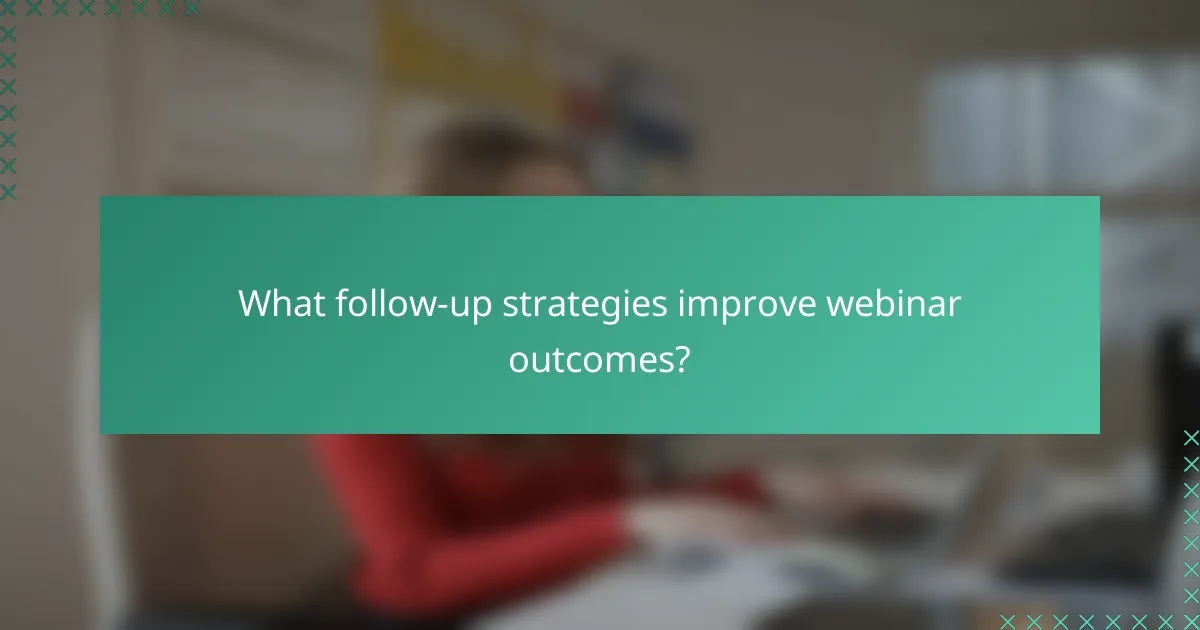
What follow-up strategies improve webinar outcomes?
Effective follow-up strategies can significantly enhance the outcomes of webinars by reinforcing the content, gathering insights, and maintaining engagement with the audience. Key approaches include conducting post-webinar surveys, sending email follow-ups, sharing relevant content, and analyzing feedback.
Post-webinar surveys
Post-webinar surveys are essential for gathering immediate feedback from participants. These surveys can include questions about the content, delivery, and overall experience, helping to identify strengths and areas for improvement.
Keep surveys concise, ideally under 10 questions, and consider using a mix of multiple-choice and open-ended questions. Aim for a response rate of at least 20-30% to ensure the feedback is representative.
Email follow-ups
Email follow-ups serve to thank attendees and provide additional resources. Sending a follow-up email within 24 hours can help reinforce key messages and keep the conversation going.
Include a summary of the webinar, links to the recording, and any promised materials. Personalizing these emails can increase engagement, so consider addressing recipients by name and referencing specific topics they showed interest in.
Content sharing
Sharing relevant content after the webinar can extend its value and keep the audience engaged. This may include slides, articles, or related videos that complement the topics discussed.
Utilize platforms like social media or your website to distribute this content widely. Consider creating a resource hub where attendees can easily access all materials related to the webinar.
Feedback analysis
Analyzing feedback from surveys and interactions can provide valuable insights into audience preferences and behaviors. Look for trends in the data that highlight what worked well and what did not.
Use this analysis to inform future webinars, adjusting content, format, or delivery methods based on participant feedback. Regularly reviewing feedback can help refine your approach and improve overall engagement in subsequent events.

What tools help mitigate technical difficulties in webinars?
Several tools can effectively reduce technical difficulties during webinars, ensuring a smoother experience for both hosts and participants. Key platforms like Zoom, Webex, and OBS Studio offer various features that address common issues such as connectivity, audio-visual quality, and streaming capabilities.
Zoom for reliability
Zoom is widely recognized for its reliability in hosting webinars, with robust features that support large audiences. It offers high-quality video and audio, even in low-bandwidth situations, making it a preferred choice for many organizations.
To enhance reliability, ensure that you conduct a test run before the actual webinar. This allows you to check your internet connection, audio settings, and video quality. Additionally, consider using Zoom’s cloud recording feature to capture the session for later access.
Webex for features
Webex stands out for its comprehensive set of features that enhance user engagement and interaction. It includes tools like polls, Q&A sessions, and breakout rooms, which can help keep participants involved and minimize technical disruptions.
When using Webex, familiarize yourself with its interface and features ahead of time. This preparation can help you utilize its capabilities effectively during the webinar, ensuring a seamless experience. Also, consider enabling the automatic transcription feature to provide accessibility for all attendees.
OBS Studio for streaming
OBS Studio is an open-source software that excels in streaming and recording webinars with high production quality. It allows for customizable scenes and transitions, enabling hosts to create a professional-looking presentation.
To effectively use OBS Studio, invest time in learning its interface and features. Set up your scenes in advance and test them to avoid any last-minute issues. Additionally, ensure that your computer meets the necessary specifications to handle streaming without lag, as this can significantly affect the viewer experience.
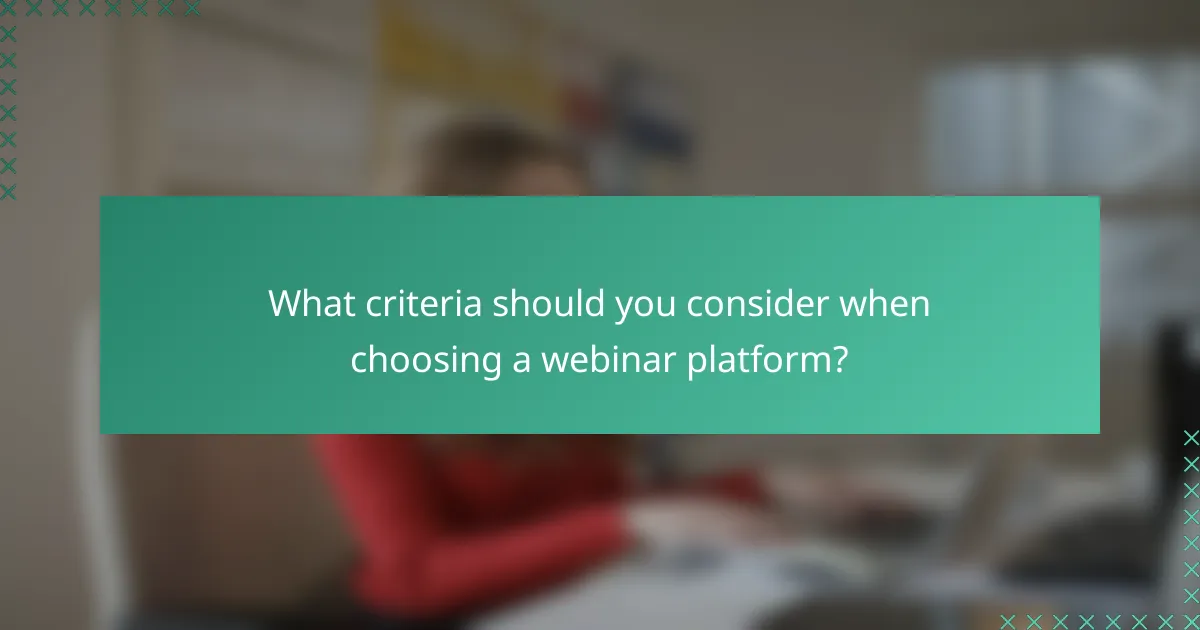
What criteria should you consider when choosing a webinar platform?
When selecting a webinar platform, consider factors like ease of use, audience capacity, engagement features, and technical support. These criteria will help ensure a smooth experience for both presenters and participants.
Technical difficulties
Technical difficulties can disrupt a webinar, making it crucial to choose a platform known for reliability. Look for platforms that offer features like automatic updates, high uptime percentages, and robust customer support to quickly resolve issues.
Test the platform’s compatibility with various devices and browsers to minimize potential problems. Ensure that it supports common operating systems and has a mobile-friendly interface for participants who may join from smartphones or tablets.
Audience engagement
Engaging your audience during a webinar is vital for retention and interaction. Choose a platform that offers tools such as polls, Q&A sessions, and chat functionalities to foster participation and keep attendees interested.
Consider platforms that allow for breakout rooms or small group discussions, as these can enhance interaction and create a more personalized experience. Look for options that enable you to track engagement metrics, helping you assess what works best for your audience.
Follow-up issues
Effective follow-up after a webinar can significantly impact attendee retention and future engagement. Select a platform that provides easy access to attendee data, including contact information and engagement levels, to streamline your follow-up process.
Utilize automated email features to send thank-you notes, additional resources, or recordings of the webinar. This not only reinforces the content shared but also encourages ongoing communication and relationship building with your audience.
